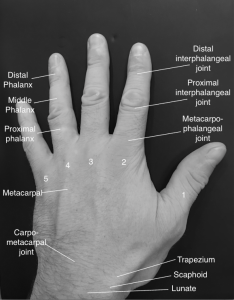Due to the frequency of hand contact, the impact with which this contact occurs and the complexity of the region, injuries to the hand and wrist are by far the most documented injuries in striking combat athletes.
The impact related to punching results in a positive remodelling of bone and soft tissue over time, causing the tissues to become stronger and more resilient. We refer to this process as wolf’s law, which states that bone will respond to direct stress by remodelling to become more resistant to stress. Long-term karate practice has been shown to have a positive effect on hand bone health(1). However, as with any tissue exposed to dynamic movement, there is always the risk of both acute and/or chronic overload. Also, whilst an optimal hand and wrist position with punching decreases the likelihood of injury (proper technique development has been empirically shown to decrease fracture rates (2)) given the dynamic and unpredictable nature of fighting, landing a punch with correct technique can never be guaranteed. Even in the practice of heavy bag training, a high incidence of hand and wrist injury has been reported (3).
Due to the complexity of the region it is important to have a good understanding of the bony anatomy. The two long bones of the forearm articulate with the first of two rows of carpal bones. These then in turn articulate with the metacarpals, the longer bones that run the length of the hand. There are 5 metacarpals, corresponding to each finger, and we refer to these in rows, from 1 (thumb) to 5 (little finger). Each metacarpal then articulates with the proximal phalanges. We refer to this joint as the metacarpophalangeal joint, and it is this joint that forms the knuckle of the hand, the primary point of striking impact. The proximal phalanx joins the middle phalanx, which then joins the distal phalanx, forming the proximal and distal interphalangeal joints respectively. This multitude of bony structures are held together by a complex web of ligaments.
Over the next few posts we will discuss common injuries that occur in striking sports.
References
1. Drozdzowska B, Münzer U, Adamczyk P, Pluskiewicz W. Skeletal status assessed by quantitative ultrasound at the hand phalanges in karate training males. Ultrasound Med Biol. 2011;37(2):214–219.
2. Drury BT, Lehman TP, Rayan G. Hand and wrist injuries in boxing and the martial arts. Hand Clin. 2017;33(1):97–106.
3. Potter MR, Snyder AJ, Smith GA. Boxing injuries presenting to US emergency departments, 1990–2008. Am J Prev Med. 2011;40(4):462–467.
#thescienceofstriking #handinjuries #boxing #combatsports #punching #physiotherapy

